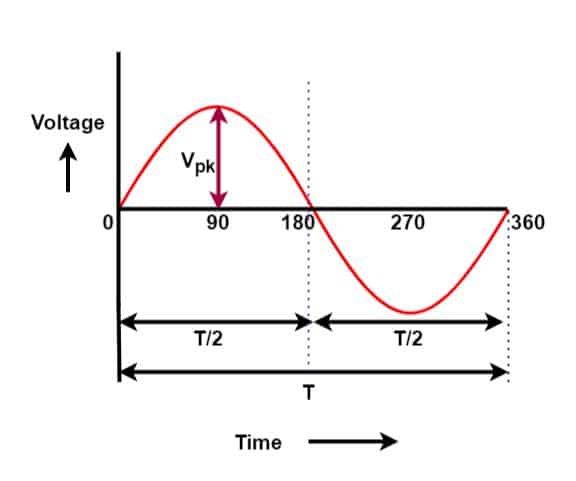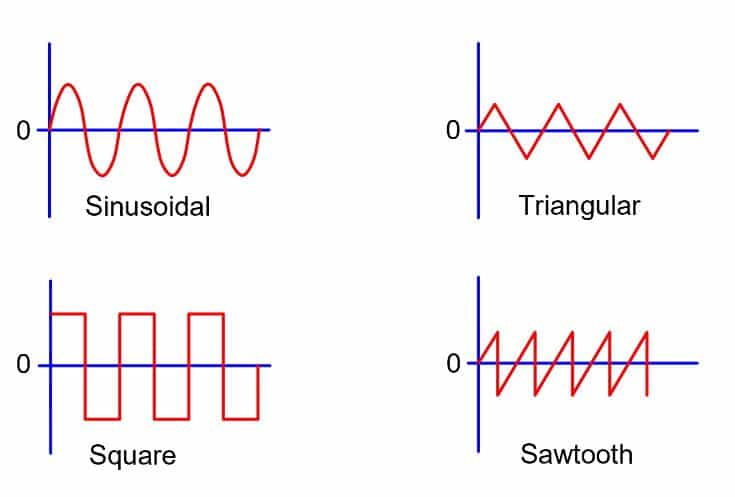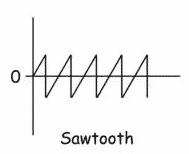Definition of Alternating Current
The alternating current reverses its direction, and its instantaneous magnitude changes with time. However, the RMS value remains the same for a particular load. The alternating current changes its direction periodically. Conversely, the DC current does not change its direction, rather it flows in one direction only.

Alternating current has a periodic function. The alternating current is named according to the pattern of the waveform. Thus, the current waveform may be sinusoidal, square, triangular, sawtooth, trapezium type, etc. The alternating current waveform has an equal area of the positive and negative half cycle. Therefore, the average value of the pure sinusoidal current waveform is zero. The different types of alternating waveforms are ;

Measurement of Alternating Current
We can measure the alternating current using a moving iron-type ammeter. However, the PMMC meter is not suitable for AC current measurement. The PMMC meter functions on average value measurement. The average value of AC is zero, hence we can not use the PMMC meter for the measurement of alternating current. However, it is possible to measure AC current with a PMMC meter if we rectify the alternating current.
The digital multimeter is now used for the measurement of voltage, current, and many other electrical quantities. The digital clamp meter is widely used to measure the AC current flowing in the circuit.
RMS Values of Alternating Current
The value of alternating current is expressed with its RMS value. RMS value is the effective value of a varying voltage or current. It is the equivalent steady DC(constant) value that gives the same heating effect. For example, a lamp connected to a 6V RMS AC supply will shine with the same brightness when connected to a steady 6V DC supply. RMS value of the different waveforms is given below.
| Waveform Type | Waveform | RMS value |
| Sinusoidal waveform |  |  |
| Square Waveform |  |  |
| Sawtooth Waveform |  |  |
Where, Im is the peak value of the AC waveform.
Advantages of Alternating Current or AC
The followings are the advantages of alternating current.
- The generation of alternating current is very simple. The alternator does not require a commutator or a rectifier circuit. Thus, large AC power is possible to generate without any complex circuitry.
- The load centers are usually located at a far distance from the generating station. For transmission of power, the voltage needs to step up to reduce the line losses. At the receiving end, the voltage needs to step down for power utilization. The transformer functions if AC is fed to it. Thus, we can say it is easy to raise or lower the AC voltage by the transformer.
- It is possible to reduce the AC current by a current transformer for measuring and protection purposes. Therefore, it is easy to protect the electrical network.
- It is easy to convert AC into DC with an electronic rectifier. In DC drives, we convert the AC into DC for driving the DC motor.
Disadvantages of Alternating Current
The followings are the disadvantages of alternating current.
- Alternating current has a skin effect. The alternating current tends to flow at the outer surface of the conductor. This phenomenon is called the skin effect. The skin effect depends on the frequency of the AC & it increases with an increase in frequency. The skin effect increases the effective resistance of the conductor, and thus it causes more line loss. The stranded conductor is used to reduce the skin effect. Also, we use hollow conductors to reduce the skin effect in HT applications.
- The proximity phenomenon in alternating current causes non-uniform distribution of the conductor. The magnetic field of the current-carrying conductor links to the neighboring conductor and vice versa. Thus, the current distribution in both conductors becomes non-uniform.
Alternating Current in Three-Phase System
Alternating current in a three-phase system has the following features.
- The vector sum of all three-phase current is zero for a balanced three-phase system. However, for an unbalanced three-phase system vector sum of phase currents is never zero.
- The phase angle between phase currents is 120 degrees (Electrical). The angle between the phase current changes with unbalance of voltage. Therefore, for a balanced system, the type of load & load value for each phase must be the same.
Read Next: